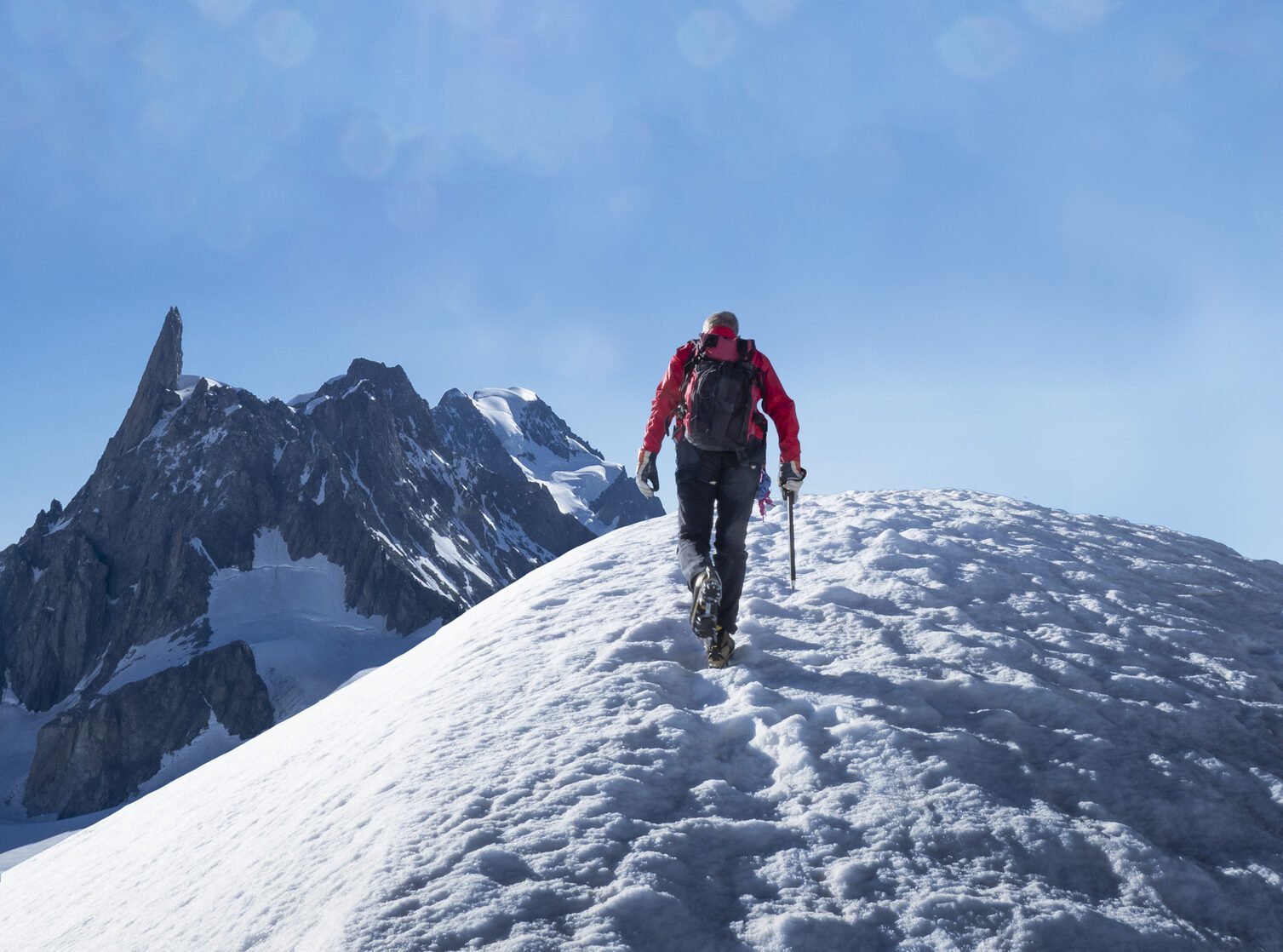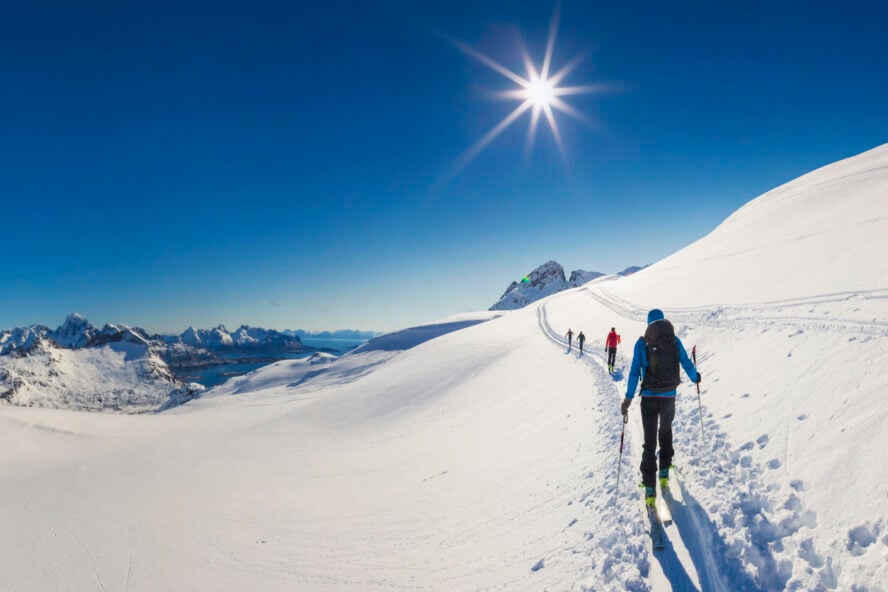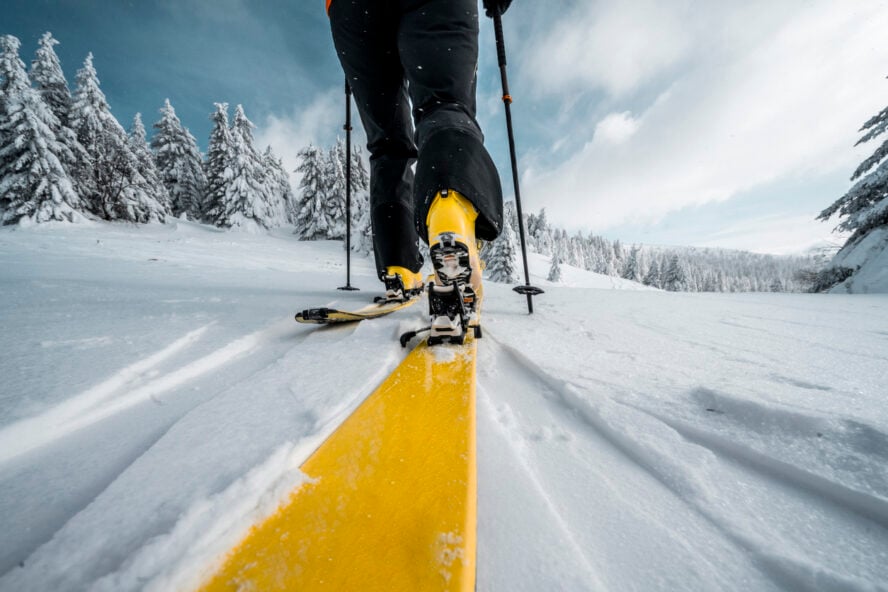Backcountry skiing has grown in its popularity throughout the North America and Japan. But what all Europeans know, and some Americans and Japanese may not be familiar with, is that Europe, specifically the Alps, remains unrivalled as a go-to destination for extreme, technical backcountry terrain. The Alps offers and delivers diverse and stunning routes for experienced and amateur skiers alike. There’s Mont Blanc, Matterhorn and Meije to name only a few. These are perhaps three of the most celebrated areas in European backcountry lore, but they remain so firmly entrenched in our minds because of their open exposure, thrills and challenging terrain that the world never ceases to tire from. The apres scene on the continent isn’t too bad either!
1. Chamonix
Chamonix maintains its deep-rooted allure for adventurers everywhere for good reason: it’s the birthplace of mountaineering, modern skiing and mountain guiding. The town is situated in a valley beneath the highest peak in the Alps, Mont Blanc, where it annually attracts skiers, climbers and mountaineers by the tens of thousands. Its historical importance is palpable and its legendary backcountry terrain is at the top of many a bucket list for good reason: there’s 11 ski areas to choose between, all of which offer skiing that is second to none. It’s also the starting location of the much revered Haute Route where you can ski from Chamonix and Mont Blanc to Zermatt and the Matterhorn. For serious off-piste skiers, be sure to consider these three areas for mind-bending runs, terrain and powder:
Les Grands Montets – Argentiere, a small village about 4 miles from Chamonix, is the starting point for mountaineers and skiers to gain access to Les Grand Montets via the Telepherique du Lognan cable car, where skiers will find themselves at a comfy elevation of 10,810’. The off-piste skiing potential here is huge and glacial, with much of it above tree-line and wide open. And very, very popular
Brevent – Flegere – Accessible via Chamonix (Brevent) or the nearby village Les Praz (Flegere), the terrain here is linked, thus the hyphen, and provides ample glacier, ridge and bowl skiing well above the treeline. This area doesn’t get as tracked out as others in the valley and it’s a great place for deep powder skiing and steep, steep lines.
La Vallee Blanche – For some skiers, getting to La Vallee Blanche can be almost as much fun as skiing all the way back to Chamonix: once you make it to Aiguille du Midi via a cable car that gains 9,200’ in elevation in only 20 minutes, you’ll begin your ascent from the station via a knife-edged ridge where there’s no room for error and 50° falls on either side – there’s a cable to hold onto. No worries. With the ascent into La Vallee Blanche, you’ll have an epic 20km day ahead of you completely off-piste as you ski back down to Cham.
Don’t let the picture-perfect views make you forget that avalanches and other pitfalls are a reality here as they are anywhere else. Chamonix is known as the “death-sport capital of the world.’ No joke. While access to backcountry terrain is quick and easy, hire a guide and don’t underestimate any of it no matter how easy it is to get to.
Chamonix backcountry skiing is as good as it gets, and a tour through Vallee Blanche, Col du Passon and Col de Beugeant will have you yearning to get to this incredible off-piste area.
Chamonix - Good to Know
Intermediate to expert
Depending on which area you visit, you can expect to find pillows, glaciers, drops, bowls, and tons of powder-filled open fields
3,396′
Lift serviced and abundant
Powder fields abound, especially at higher elevations. Average snowfall is 429” annually
Mont Blanc and the Aiguilles Rouges: A Guide for Skiers by Anselme Baud. Yes, it’s in English!
January through March
Haute-Savoie, southeastern France
45.9237° N, 6.8694° E
2. La Grave
La Grave is all that its name implies: it’s a severe, serious, and gnarly area, and its powder and lines are truly incredible. The town itself is tucked away and only dedicated, avid skiers make the journey. Those who do are richly rewarded. The skiing area is vast and untamed, and, thankfully, never crowded. The town itself is sleepy and content with its status as a ski area playing hard-to-get. The signage on the runs is as existent as avalanche control is on the mountain. But, hey, if you’re going there, you probably know all this and can’t wait to ski in a truly one-of-a-kind place. Perhaps here, more than anywhere else, get a guide and make your first earned turns safe and sound.
A couple routes in the area include Couloirs du Lac and Vallon du Diable. The former offers great steep skiing and can be combined with other runs via Girose Glacier. It offers plenty of couloirs, but without prolonged high angle runs, thus making for a good intro to the area. Vallon du Diable is a much longer ride with a more difficult entry, but it’s run throughout the valley makes it worthwhile, and the area is known for ice climbing as well. Regardless, though, take note of the signage: “Beyond this point you face dangers and complex routes requiring mountaineering experience and proper equipment. Once you start out, it’s very difficult to turn back. Please ask for advice before!” Ask for advice indeed. Enjoy La Grave, and take the time to get to know it. Your thoughts on skiing the backcountry won’t ever be the same after you’ve skied here.
La Grave - Good to Know
Strong intermediate to expert
Gnarly and big!
La Meije 13,064’
Two-stage lift. First stage at 5905’, second stage 10498’. After that, there’s a t-bar for a little extra vertical gain. After that, It’s all downhill from there
Incredible and abundant
La Grave, L’Alpe d’Huez, Les 2 Alpes Off Piste by Francis Ginet and Fabrice Villaret (English AND French)
Late winter through early spring
Southeast France, Hautes-Alpes
45°02′49″N 6°18′24″E
3. Zermatt
Located in the Swiss Alps and very close to Italy, Zermatt is famous for its proximity to the Matterhorn. This majestic peak is admired by skiers, mountaineers, hikers and every outdoor adventurer. The Matterhorn isn’t the only draw, though, the valley in which Zermatt is situated is home to thirty eight 13,000’ peaks. Some say that the scenery alone is worth the visit but it doesn’t mean that this is only thing to check out in Zermatt. This place offers 365 days of snow and very convenient off-piste access. Most backcountry skiers will make a combined trip and visit Cervini, an Italian resort on the other side of the Matterhorn. Between those two towns there’s 223 miles of skiable terrain most of it above 6,000’ in elevation, which makes Zermatt a popular bucket list entry.
The best skiing at Zermatt for the backcountry is the Stockhorn face. Here there’s official ungroomed double black runs that offer incredible bumps of eleven hundred meters (Triftji) on the north face, and then there’s unofficial runs on either side that area that are ripe for the taking. Great care needs to be taken here, because crevasses are an issue, as are avalanches. Consider hiring a guide if you’re new to the area. There’s no crevasse danger on the other side of the face, and the bowls on offer feature plenty of rocks and small cliffs. So plan your route accordingly.
Also not to be missed is the Matterhorn Glacier Paradise at the Klein Matterhorn area. This area offers 36km of backcountry runs, including a huge drop of 7200’ that’ll take you back to town. The terrain here has been made ‘safer’ to backcountry dangers by having certain areas filled. What’s inbounds is plenty for a day of longer runs, but if you venture out of bounds, crevasses, avalanches and all the rest are a reality and must not be ignored.
Zermatt - Good to Know
Intermediate to expert
There’s a vertical descent of 7,477’. The terrain options are near everything you can think of
Zermatt sits at 5,276’
The best off-piste terrain can be accessed via surface tows (tough luck for snowboarders)
Zermatt is one of the rare places in Europe where you can ski even in the summer! Many routes are north facing which is good news for everyone
Check out this panoramic map of the area
Late March through early May
Canton of Valais, Switzerland
46°01′N 7°45′E
4. Verbier
There wasn’t really a formal competition but Verbier is often mentioned as one of the best off-piste destinations in Europe. This can be mostly contributed to the large area it covers and convenience of access. Verbier is a part of Switzerland’s famous Four Valleys ski area which has 256 miles of skiing terrain combined. With near perfect ski lift infrastructure, it allows for easy access to freeride areas. This off-piste mecca offers many options that mostly cater to intermediate and pro skiers so you better prepare in advance to make the most of your stay here. It’s a great place for families because the resort caters to non skiers also.
Within Verbier and the Four Valleys, there are two other designations for backcountry excursions: there’s Ski Tours and High Mountain Tours. Both of these are not marked, maintained, controlled, and all the rest. They are intended for the advanced and expert backcountry skier only. So make sure you know what you’re getting into before you make your ascent. Or better yet, go with a guide! The terrain on offer via lift is incredible. Mont Gele, part the range north of Mont Fort, when open, offers zero groomed runs down and sits at 9917’. There’s plenty of mogul runs as well at Tortin Plan du Fou and Gentianes. If you’re looking for tree runs too, make your way over to Bruson and you won’t be disappointed. The back of Mont Fort will treat you to views of the Matterhorn and Mont Blanc, and then, if you can handle it, especially with a guide, there’s the Bec des Rosses, home of the Freeride World tour. Regardless of how intense the backcountry terrain can be at Verbier, the area and its surroundings have plenty of terrain for the new off-piste skier too.
Verbier - Good to Know
Intermediate and expert with few options for beginners
Steep and intermediate runs, large powder fields. Couloirs, bowls, tree runs, glaciers, chutes, this places has almost everything
4,921’ – Verbier resort altitude
Easy access due to excellent ski lift system
There’s plenty of it, but it can get tracked out quickly on weekends
Freeride Verbier by Gilbert Crettaz
January through March
Canton of Valais, Switzerland
46.0961° N, 7.2286° E
5. Dolomites
Located in northeastern Italy, the Dolomites, part of the Southern Limestone Alps, offer tons of skiing options across 12 linked resort areas. While the peaks of the Dolomites may not outstrip the height and powder of those northwestern Italy, they do offer incomparable surroundings and tons of touring options. For a lot the backcountry runs available in the Dolomites, hiring a guide is almost a necessity due to the resorts offering very little off-piste action of their own. A lot of good runs are hard to find and reading the terrain is still an essential part of any tour. A couple resorts stand out from the other for their off-piste offerings: Val Gardena, Arabba Marmolada and Val di Fassa.
Lots of backcountry routes are based around Marmolada (the highest mountain in the Dolomites), the peaks of Belvedere and the Sella massif north of Marmolada), most of which have slackcountry access at the resort. Because the area doesn’t receive the snowfall as it does elsewhere in Europe, power days are quick to get tracked out, but are still worth the effort and trip, due to the stunning mountains on offer. Though the area gets less traffic than elsewhere, keep in mind that avalanche conditions still need to be heeded, also, be mindful of crevasses when skiing Marmolada.
Dolomites - Good to Know
Intermediate to advanced
Glaciers, bowls, chutes, some tree skiing too
Marmolada is the highest mountain at 10,968’
Most resorts in the area offer slackcountry access, but the rest is best left to a guide
There’s usually enough, but the region isn’t dumped on like other parts of the alps
Ski Mountaineering in Dolomites by Enrico Baccanti and Francesco Tremolada
January through mid-March
South Tyrol, Italy
46.4102° N, 11.8440° E
6. St. Anton
St. Anton’s renown comes from its world-class offerings both on and off-piste. If you want to go off-piste and have the scare of your life, consider taking the Valluga 2 cable car to the highest point and let er’ rip (though, you must have a guide with you to even make it this far!). The terrain is steep and there’s always plenty of powder in this area of the Alps. One thing to keep in mind is that the off-piste terrain here demands and commands your attention, so definitely consider a guide.
On top of the backcountry conditions, St. Anton also ranks among 50 of the best snowparks in Europe, according to Ridestore Magazine. They’ve awarded it a badge for being one of the best places for improvers, saying, “St. Anton park has created a set up to suit all levels, the proline will push you and the medium lines will help you build your skillset.”
Equally as famous as the backcountry powder and the epic snowpark, St. Anton’s apres will have you partying as hard as you ski.
St. Anton - Good to Know
Intermediate to expert
Above tree line, plenty of bowls, cirques, chutes and powder fields
4,994′ base
Lift serviced with plenty of options
Continental perfection
The Arlberg Ski Touring Guide by Andy Thurner
January through March
Tyrolean Alps, Austria
47.1296° N, 10.2682° E
7. Courmayeur
While not to be overlooked by bolder face named nearby resorts, Courmayeur is an attractive candidate for exploring the sunny side of Monte Bianco. While the resort itself has plenty on offer, the good, challenging lines are most rewarding. Consider varied options form Cresta d’Arp at 9038’ or ski the famed Vallee Blanche and head to Chamonix! For the more technical runs, hire a guide. There’s plenty of 40° angled routes to be shredded and the lift service offers quick rides to challenging terrain. Some classic routes include Arp Vieille, where you’re in for a descent of 2624m with fantastic views of glaciers and good couloir and bowl skiing too. The Arp Dolonne is another route worth discovering off of the Cresta Youla and Create D’Arp lift. This route has ample powder all season long and offers plenty of choices for descent along the way.
Courmayeur - Good to Know
Intermediate to expert
Tree skiing, chutes, bowls, cirques, glaciers and moguls!
4,016′ base
Plenty of lift serviced backcountry access
Excellent continental pack
Don’t let the title fool you. Mont Blanc Freeride by Domenico Gusti and Giorgio Passino
Mid-January to March
The sunny side of Monte Bianco (Mont Blanc), Italy
45.7969° N, 6.9690° E








































